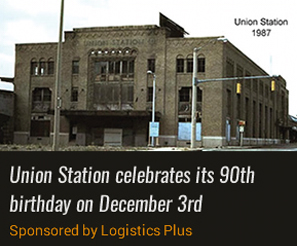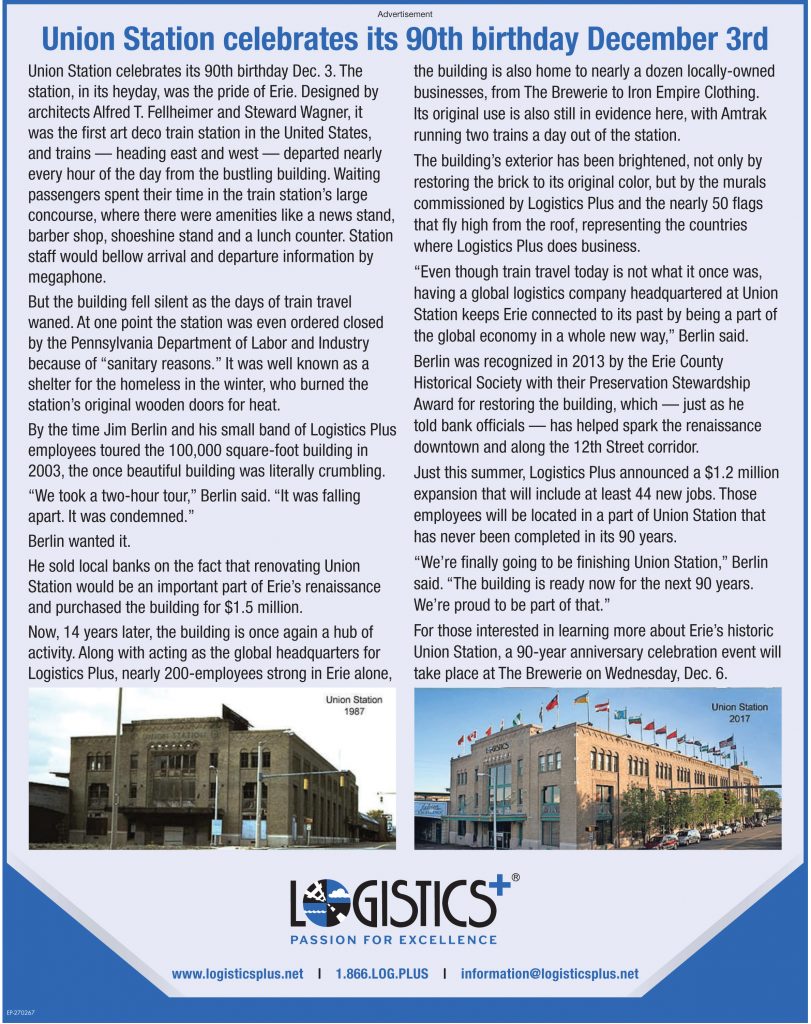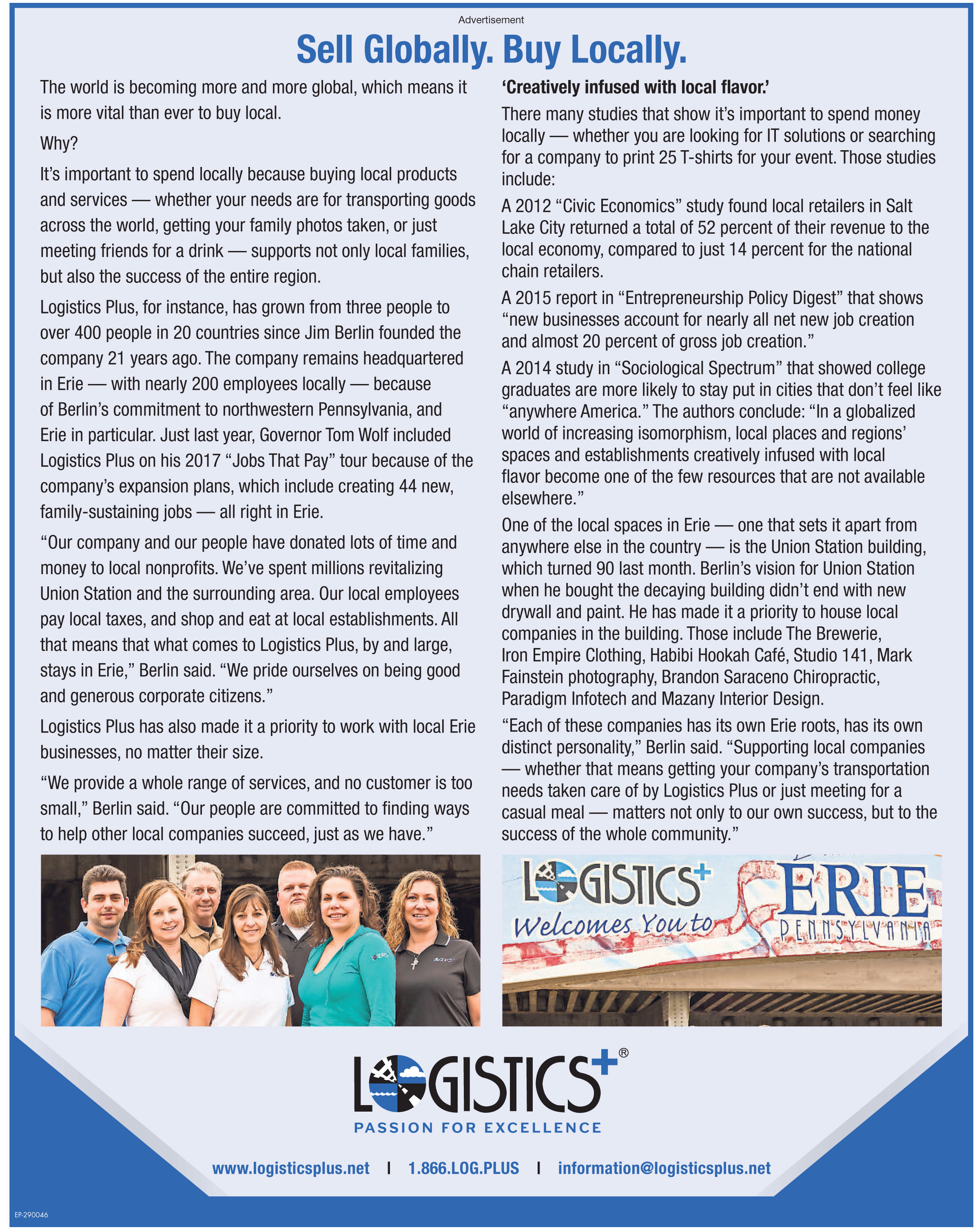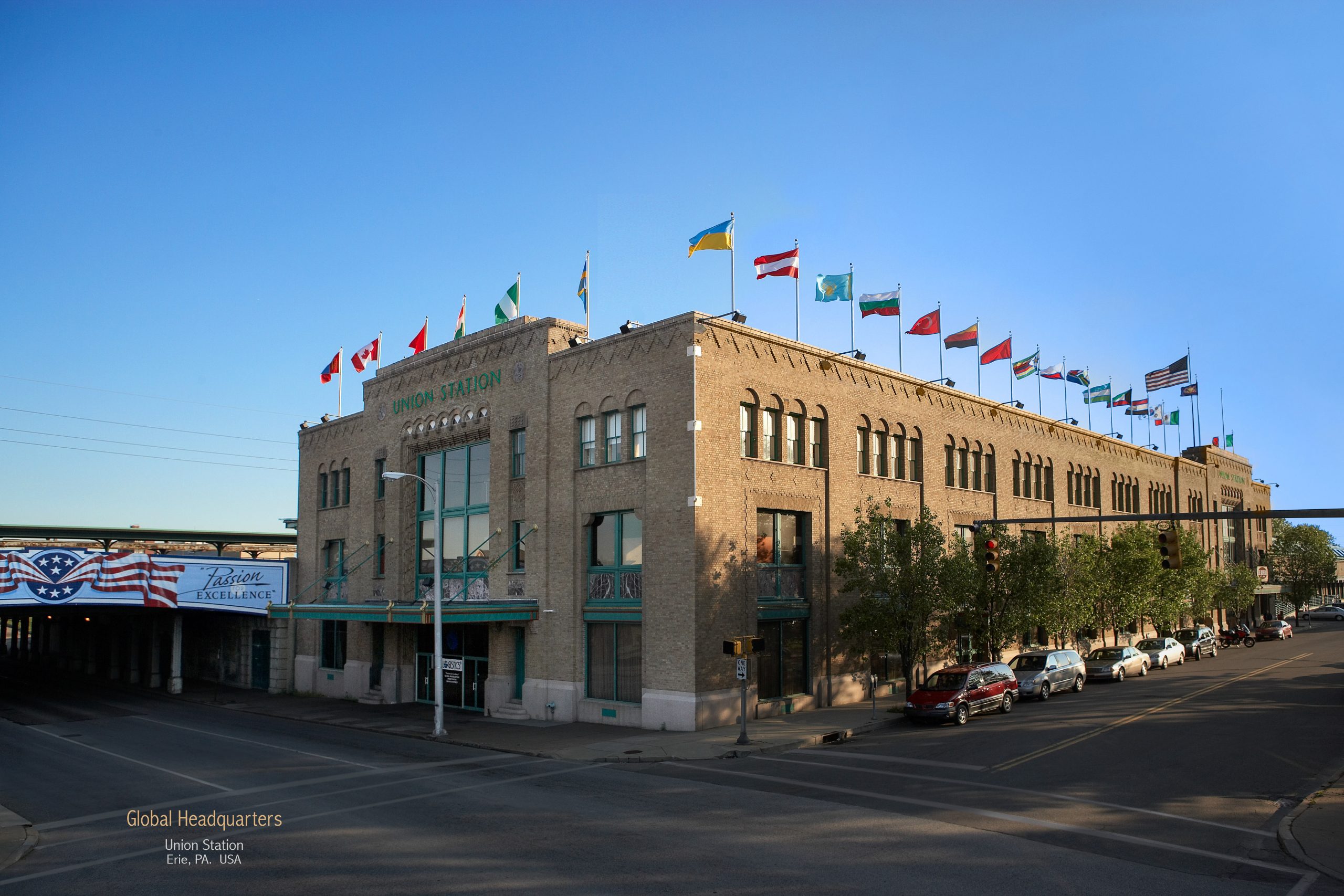
by logisticsplus | Dec 7, 2017 | News
(Editorial piece published December 7, 2017)
Bold Union Station gamble pays off for Erie
Erie Times News Editorial Board
Erie Insurance, UPMC Hamot, Saint Vincent Hospital and Scott Enterprises have put in motion downtown Erie development plans worth hundreds of millions of dollars, all of it progress to be celebrated.
Not be lost amid that near embarrassment of riches is the foresight and courage of earlier, stalwart pioneers of downtown Erie’s recovery like Logistics Plus founder and CEO Jim Berlin.
As detailed by Erie Times-News reporter Jim Martin, Erie-based Logistics Plus is celebrating the 90th anniversary of the 1927 dedication of Union Station, an Erie landmark and architectural gem that owes its survival in large part to Berlin’s vision.
Berlin in 2003 took a gamble on the once-crumbling property facing Griswold Park at a time when little portended good for that part of downtown.
Amtrak and the YWCA then occupied the historic structure, recognized as the nation’s first art deco rail station. Porter’s Restaurant & Tap Room and Sabella’s operated in an area that had been refurbished.
The rest of the 100,000-square-foot building, though? “A dump,” Berlin told Martin. Animals had taken up residence, as had homeless people.
Berlin saw all that and wanted to buy the rail station anyway and make it home to his own transit-oriented company, which provides transportation and logistics services around the world.
Logistics Plus at that time employed about 30 people in Erie. Its Union Station headquarters now houses 115 workers.
Erie’s original microbrewery, The Brewerie at Union Station, fills the former rail station’s rotunda. Vitality has flowed into the neighborhood as well.
Griswold Park has been spruced up and graced with a new fountain and plantings. Another grand building, the former Griswold Plaza post office that sits across from Union Station, was purchased by Erie lawyer Andrew Sisinni in 2010 and houses tenants.
The Erie Redevelopment Authority’s ambitious plans for the Union Square area, bound by West 12th and West 14th streets, between State and Peach streets, faltered. But market-rate development there may yet be realized by Erie developer Rick Griffith.
Development of Union Station is ongoing. Berlin and Gov. Tom Wolf announced in August that the company plans to expand into a never-used part of Union Station and add 44 new jobs in the process.
Soon, the renewal emanating from Union Station might be answered with new development in the nearby 12th Street corridor, where Erie businessman Peter Zaphiris recently purchased a number of parcels that he said he aims to develop “for the betterment of Erie.”
Berlin’s decision to invest in Union Station exhibited both respect and dedication to Erie’s proud past and abiding faith in its future. And it’s become an anchor of its present.
It figures as an enduring lead for others to follow.

by logisticsplus | Nov 28, 2017 | News
 Through its partnership with Erie Times-News and GoErie.com, Logistics Plus is being featured in multiple issues of the publisher’s Lake Erie Lifestyles magazine. The first segment appeared in the August 2017 issue and discussed how Logistics Plus attracts and retains young talent within the Erie community. The second segment appeared in the September 2017 issue and highlighted how Logistics Plus supports #MyErie. The new, third article showcases the upcoming 90th anniversary of the historic Union Station building and was featured in the November 2017 issue of the magazine (which is inserted monthly into the Erie Times-News newspaper). A reprint of the feature, which is shown below, is also available online at www.goerie.com/lifestyle/lake-erie-lifestyle. You can click the image below to see the larger, online version.
Through its partnership with Erie Times-News and GoErie.com, Logistics Plus is being featured in multiple issues of the publisher’s Lake Erie Lifestyles magazine. The first segment appeared in the August 2017 issue and discussed how Logistics Plus attracts and retains young talent within the Erie community. The second segment appeared in the September 2017 issue and highlighted how Logistics Plus supports #MyErie. The new, third article showcases the upcoming 90th anniversary of the historic Union Station building and was featured in the November 2017 issue of the magazine (which is inserted monthly into the Erie Times-News newspaper). A reprint of the feature, which is shown below, is also available online at www.goerie.com/lifestyle/lake-erie-lifestyle. You can click the image below to see the larger, online version.
Following the image below, there is another cool read in the form of a recently written article by Nathan S. Clark, Jr., CTL, regarding Union Station’s history and forthcoming anniversary.

Erie Union Station turning 90 on Sunday, December 3, 2017
by Nathan S. Clark, Jr., CTL
One of Erie’s most prominent landmarks will officially turn 90 years old in less than two weeks. Dedicated with much fanfare by excited citizens and dignitaries on Saturday, December 3, 1927, Erie Union Station was completed by the New York Central Railroad (NYC) during the heady days of the Roaring Twenties. It was also toward the end of the Golden Age of the American passenger train.
Located at 1406 Peach Street in midtown Erie, the station occupies an entire city block along West 14th Street’s south side, between Peach and Sassafras streets. Nine decades ago, it was viewed by its promoters, planners and city residents as a powerful new symbol of Erie’s economic growth and promising future. Few of the revelers at the grand opening would have suspected on dedication day that Union Station would not serve throngs of intercity travelers for many decades to come. A trio of events earlier in 1927, however, had already forecast a permanent shortfall in future railroad riders by the time the doors first opened at the station that December.
First, when Charles Lindbergh had become the first person to fly solo across the Atlantic Ocean to mainland Europe in May, he highlighted that aircraft could conquer space and time anywhere on the globe. The intense world attention he drew to the possibilities of moving people in the skies captured the collective imagination of a planet of people whose travels had been bound by gravity to the earth or seas, throughout human history. The public reaction to his historic flight even stunned Lindbergh, who later said, “I was astonished at the effect my successful landing in France had on the nations of the world. To me, it was like a match lighting a bonfire.” And indeed, it was. For most long-distance passenger trains in America, though, it was instead as if a fuse had been lit toward their demise.
Another lightning strike for the passenger train came out of the sky when Pan American Airways took to the air on October 19, 1927. Pan Am would flourish and go on to set the standards for service that would be followed by other emerging commercial airlines. Just over seven weeks before the festivities in Erie to celebrate the opening of Union Station, the developing airline industry began in earnest a process that would ultimately divert huge numbers of future passengers from long-distance trains.
But the darkest cloud for Erie Union Station’s passenger train ridership ‘blew across Lake Erie’ from Michigan less than 24 hours prior to the building’s dedication! By 1927, the country had already been getting acquainted with the automobile for over a quarter-century. In late May, Ford Motor Company announced it would discontinue production of its immensely successful Model T, after turning out over 15.5 million of the popular cars. What followed would further help doom any bright outlook for Union Station.
On December 2, literally just the day before Erie Union Station was dedicated, an estimated 10 million people flocked into Ford showrooms across the continent for the unveiling of the brand-new Model A. Quite literally, right as preparations were being completed by the New York Central Railroad and Erie’s civic leaders to provide proper pomp and circumstance the next day for the opening of the new Union Station, millions of Americans ‘saw the future’. Buying decisions made that day and thereafter with car dealerships would help seal the fate of the passenger train in popular culture.
The Model A was destined to become Ford Motor’s second huge success. Americans apprciated being able to stretch their travels far beyond the limitations of railroad rails. They enjoyed the freedom and flexibility offered by a set of personally-owned rubber tires vs. ‘borrowing’ a passenger train’s steel wheels. Journeys that used to involve a train platform could simply, conveniently begin and end in a protected garage, right next to the traveler’s home.
Attendees at Erie Union Station’s dedication the very next day could hardly be faulted for not having recognized the titanic impact of the national Model A roll-out that had just occurred, as it would eventually relate to the future of their new station.
America was beginning to fall deeply in love with the automobile for most travel, and the airplane was beginning to ascend for most long-distance trips. The remaining ‘glory days’ for most railroad stations in North America as centers of human activity were numbered, in all but the largest cities.
Less than two years after the station opened, the Stock Market would crash. The severe contraction of the nation’s economy during The Great Depression through the next decade would cause railroad passenger ridership (and travel of all kinds) to plummet throughout the nation. Since trains were, at that time, still the primary way people moved between distant cities until automobiles and air travel became common after WWII, passenger ticket sales at Erie Union Station fell far short of lofty projections. The ‘Central’ found itself with a brand-new station and considerably fewer patrons than expected when it was being planned.
During the Second World War, the station saw a temporary resurgence in passenger traffic, but this increase was ‘artificial’. Thousands of young men kissed their families and sweethearts goodbye on the station’s platforms before boarding government troop trains to training camps to become soldiers and sailors and airmen. Once they came home, however, the brief WWII surge was quickly followed by a return to the steady ridership decline.
Erie Union Station was originally intended to be five-stories. Central’s management had recognized that it would probably never use all of that space, and only three floors were built, instead. The resulting structure still provided almost 100,000 square feet, most of which was never intended to support passenger services. A large percentage of the station was occupied by other offices of the railroad, plus mail and express services that provided transfer between rail and highway for the U.S. Post Office and for urgent, relatively small shipments and parcels. Even Lake Erie Perch, destined for restaurant and residential tables in distant cities, had a special, dedicated refrigerated area in the station where the fish was prepared in bulk quantities for cold shipment over NYC rails. Train dispatchers that controlled rail traffic along the segment of the Central’s famed “Water Level Route” mainline between Buffalo and Cleveland were also housed in the station.
The passenger facilities were more than adequate to serve the needs of the NYC and its ‘junior partner’ in the station, the Pennsylvania Railroad. Trains of the Pennsylvania offered patrons direct service to both Pittsburgh and Philadelphia, several intermediate stops between Erie and those cities and, of course, connections to PRR points beyond.
Today, the majority of the rail traffic that passes behind Erie Union Station carries freight. Dozens of daily trains run on CSX Transportation and Norfolk Southern Railway along the elevated ‘trackside’ of the building. Hundreds-of-thousands of tons of the nation’s commerce hustles right by the passenger boarding platforms south of the station each day. The rhythm of freight racing by the windows of Union Station at a mile-a-minute pace has been part of the pulse of the nation and the station, since the day the building was opened. Erie is the only Pennsylvania stop for Amtrak passenger trains #48 & #49, the east- and westbound Lake Shore Limited. These trains operate through Erie on their daily runs between Chicago and New York / Boston.
As the classic Art Deco building becomes a nonagenarian, it continues to serve an important role in the Erie community. While a small part of it is still a rail passenger station, most of it houses a variety of mixed-use commercial / service activities. After decades of decline and near-complete disuse, the building had long been a candidate for the wrecking ball. Thanks to so-called ‘urban renewal’ programs of the past, some municipalities elsewhere in the country now have just a parking lot where their grand rail station once stood. Erie could easily have reaped this sad outcome, too, but for a series of private owners who spared it.
Today, Jim Berlin, CEO of Logistics Plus, Inc. owns the building. For the past fourteen years, he has acted upon his vision for the station and invested well into the seven figures on renovations. Berlin relocated the world headquarters for his growing global third-party logistics and supply chain management firm into state-of-the-art, ‘Information Age’ office quarters on the top floor of the station.
Other tenants besides Logistics Plus and Amtrak include The BrewErie and Hookah Café that provide unique dining and entertainment experiences that draw people into the city, even from well beyond Erie County. The station’s ballroom has been exquisitely restored as The Concourse of Union Station, a popular venue for wedding receptions, meetings, reunions and other special occasions.
An interesting side-note regarding the anniversary of the station: it coincides with the very last runs of the Central’s legendary Twentieth Century Limited. Once known as the “Most Famous Train in the World”, the final trips left Chicago’s LaSalle Street Station and Grand Central Terminal in New York City and went through Erie on December 3, 1967. This limited-stops train did not pause at Erie, but it is worth noting that the 50th anniversary of the last time the Twentieth Century Limited would race pass Erie Union Station, before the premium service train was discontinued after 65 years, will also be on the building’s 90th birthday.

 Through its partnership with Erie Times-News and GoErie.com, Logistics Plus is being featured, once again, in the current issue of the publisher’s Lake Erie Lifestyles magazine. This new segment discusses why it’s important for northwestern PA businesses to sell globally, but buy locally. A reprint of the feature, which is shown below, is also available online at www.goerie.com/lifestyle/lake-erie-lifestyle. You can click the image below to see the larger, online version.
Through its partnership with Erie Times-News and GoErie.com, Logistics Plus is being featured, once again, in the current issue of the publisher’s Lake Erie Lifestyles magazine. This new segment discusses why it’s important for northwestern PA businesses to sell globally, but buy locally. A reprint of the feature, which is shown below, is also available online at www.goerie.com/lifestyle/lake-erie-lifestyle. You can click the image below to see the larger, online version.








 Last night, a small group of Logistics Plus representatives attended the
Last night, a small group of Logistics Plus representatives attended the 